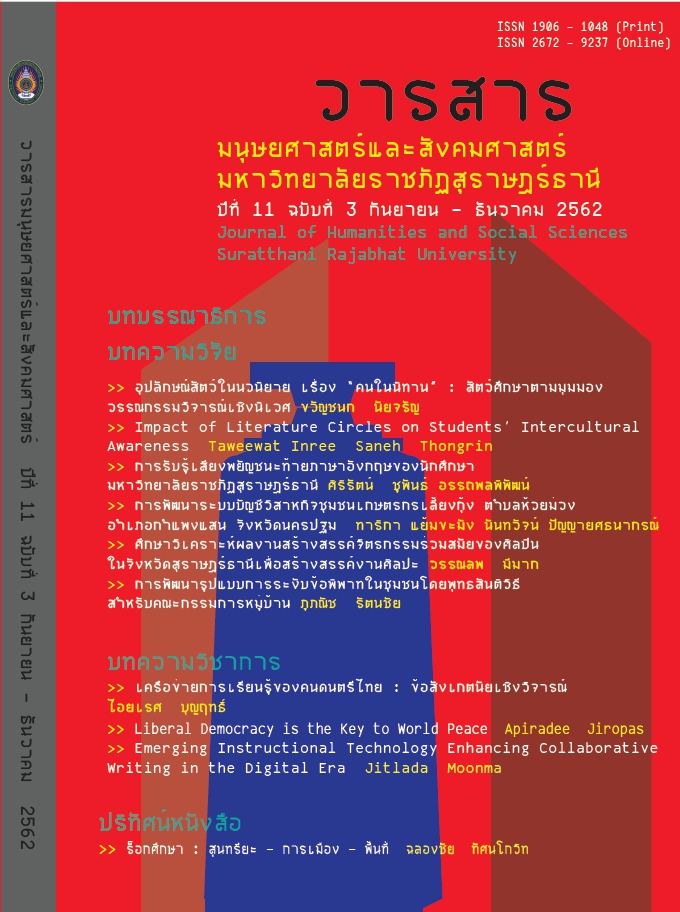The Perception for English Final Consonants of Suratthani Rajabhat University’s Students
Main Article Content
Abstract
The objectives of this research was to analyze the perception for English final consonants; fricative /f, v, T, D, s, z, S, Z/ affricate /tS, dZ/ and lateral /l/. The samples of this research were 350 Suratthani Rajabhat University’s students. 33 English words with fricative, affricate, and lateral final consonants were the instrumentation for data collection. The samples listened to 33 English words from English native speaker and then chose the word they heard in the multiple choice questionnaire. The research results showed that the samples perceived English final consonants correctly more than 50 percent. The most correctly perceived is the English final consonant /z/ (95.4 percent) and the least correctly perceived is the English final consonant /D/ (53.4 percent). [t, p, n, N, w, d, 2] are the variants which appear when the samples perceived English final consonants incorrectly. This research showed that the differences between the mother tongue language’s sound and the target language’s sound influenced the perception.
Article Details

This work is licensed under a Creative Commons Attribution-NonCommercial-NoDerivatives 4.0 International License.
All published manuscripts have been verified by peer-peer professors in the fields of humanities and social sciences. Reprinting of the article must be authorized by the editorial staff.
References
Amara Prasithrathsint. (1989). The Definition in Sociolinguistics. Bangkok: Chulalongkorn University Printing House. (In Thai)
Best, C. (1995). A Direct Realist View of Cross-Language Speech Perception. In Speech Perception and Linguistic Experience: Issue in Cross-Language Research. Strange, W. (Ed.). pp.171-204. Maryland: York Press.
Fry. D.B. (1970). Speech Reception and Perception. 5th reprint. In John Ryan. New Horizons in Linguistic. Penguin Books Ltd.
Johnson. (2010). Speech Perception. Acoustic and Auditory Phonetics, 3rd Edition. UC Berkeley Phonology Lab Annual Report.
Kamonnate Leewamoh. (2001). The Comparative Study in the Production of Final Plosive Consonants of Different Background Students. Master of Arts Thesis, Srinakharinwirot University. (In Thai)
Kanchana Naksakun. (1998). Thai Phonology. Bangkok: Faculty of Arts, Chulalongkorn University. (In Thai)
Krashen, S.D. 1987. Principle and Practice in Second Language Acquisition. Prentice-Hall International Ltd.
Ladefoged, P. (2006). A Course in Phonetics (Fifth Edition). Boston: Thomson Wadsworth.
Ladefoged, P & Johnson, K. (2011). A Course in Phonetics. Wadsworth: Cengage Learning.
Luksaneeyanawin, et al. (1997). The role of L1 background and L2 instruction in the perception of fricative consonants: Thai and English children and adults. Asia Pacific Journal of Speech, Language and Hearing 2, pp. 25-42.
Sirirat Choophan Atthaphonphiphat. (2015). Error Analysis in English Essay Writing of Suratthani Rajabhat University’s Students with Different English Language Experiences. Journal of Humanities and Social Sciences Suratthani Rajabhat University. Vol 7, No 1 January-April, pp. 25-52. (In Thai)
Sirirat Sirivisoot. (1994). Variation of Final in English Loanwords in Thai according to Style and Educational Background. Master of Arts Thesis, Department of Linguistics, Faculty of Arts, Chulalongkorn University. (In Thai)
Sranthorn Nimphaibule. (1996). Variation of Thai Air Hostesses’ Pronunciation of the Final Consonants
in English Words. Master of Arts Thesis, Department of Linguistics, Faculty of Arts, Chulalongkorn University. (In Thai)
Sudaporn Luksaneeyanawin. (2002). Psycholinguistics Handout. Department of Linguistics, Faculty of Arts, Chulalongkorn University. (In Thai)
Theraphan Luangthongkum. (2011). Thai Sound: An acoustic Study. Bangkok: Chulalongkorn University. (In Thai)
Thomason, S & Kaufman, T. (1988). Language contact, Creolization and Genetic Linguistics. Berkeley: University of California Press.


